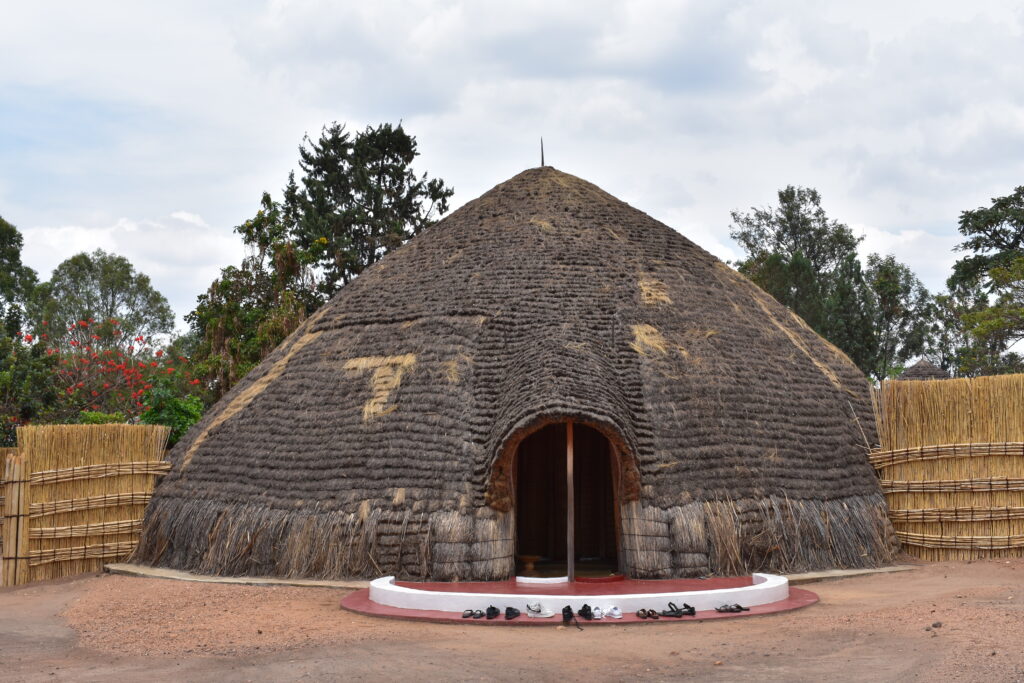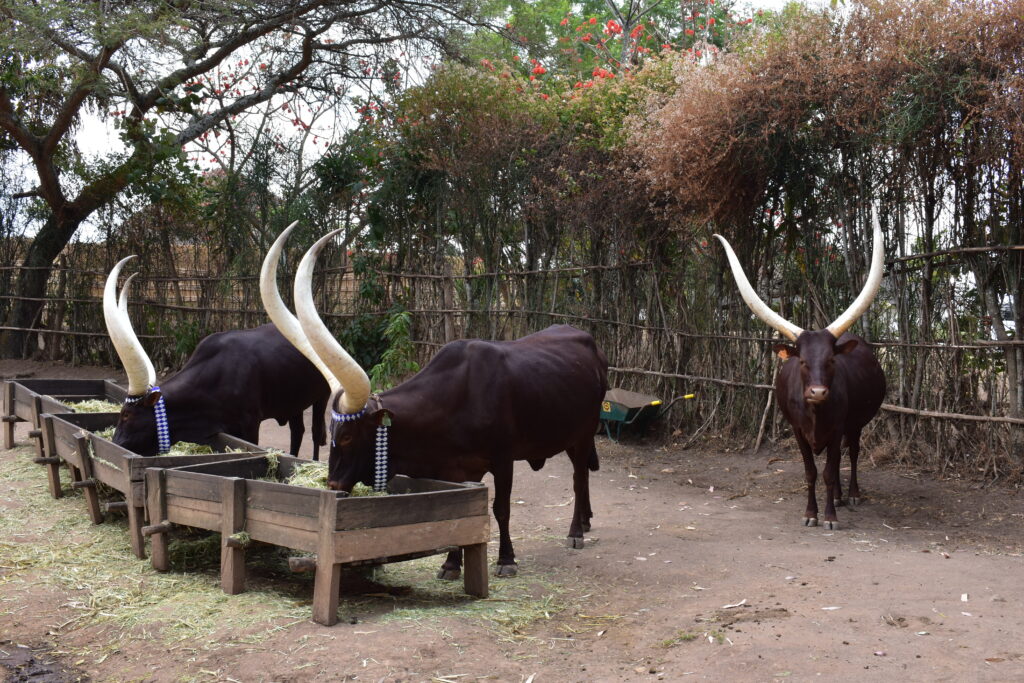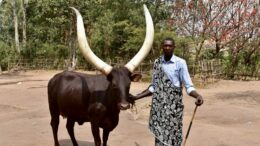Visitors to the King’s Palace Museum in Rwanda can locate the nation’s prized cows by following the sounds of singing.
Called Inyambo in Rwanda and Bihogo in Uganda, these massive cattle are known for the white, symmetrical horns that stretch into the air several feet above their heads. They’re bred for ceremonial purposes — not milk or meat, like most cattle. The museum’s herd of 15 cows, each adorned in jewelry and ribbons, stand as symbols of their longstanding significance in Rwandan culture and history.
With crooning shepherds living on site at the museum full time and a dedicated veterinarian on call 24 hours a day, these cows have the best possible care. But, like many rare livestock breeds around the world, they face challenges to their survival, including climate change, habitat erosion, disease, and international conflicts. The United Nations estimates that at least 17% of worldwide livestock breeds are threatened with extinction, and it advocates for preserving genetic lines that may have a better chance of survival in a warming, pandemic-prone world.
Conserving culturally important breeds like the Inyambo in the face of these threats presents its own set of challenges. Planning for their future starts with understanding their past — as well as their present place in Rwandan culture.
It also requires answering a tricky question: Are Inyambo an endangered species?

Counting the Uncountable
There are no monarchs in Rwanda anymore. Rwanda’s monarchy ended in 1962, when the country gained independence from Belgium. The King’s Palace Museum is a recreation of the last site of the formerly mobile monarchy, which previously moved around the country before settling in Nyanza in 1899 and establishing it as the first permanent capital of the kingdom.
The Inyambo — who roamed with the ruler until they, too, came to settle in Nyanza — are a subset of the long-horned Ankole, a breed of cattle found in Uganda, Democratic Republic of Congo, Rwanda, Burundi, and Tanzania. The Ankole themselves are a subset of Sanga cattle, indigenous breeds from southern Africa.
During the period of the traditional Rwandan monarchy, Inyambo were bred and trained for royal parades. They would be presented as dignitaries during ceremonies honoring the king.
They’re still treated like royalty today. Shepherds croon love songs to the animals to keep them peaceful and obedient. The cows, who each have a name and are tended to like members of the family, are trained to listen to their shepherds’ songs as a means of following their commands.
While the Inyambo at the King’s Palace arguably may be the happiest and most peaceful of their kind, they aren’t the only ones in existence. Small herds live in several places in Rwanda and Uganda. But calculating exactly how many Inyambo exist outside of this protected herd is difficult.
For one thing, Rwandan culture suggests that asking a shepherd how many cows he owns is akin to asking how rich he is. Boasting about the number of one’s cattle is seen as rude and puts a shepherd at risk of theft.
Beyond that, many shepherds have a deeply held cultural belief that counting animals leads to those animals’ death. Because of this, the Inyambo are not typically tagged. Recordkeeping can also vary greatly among shepherds, with some knowing the names of each animal like they’d know the names of their children and others taking a more relaxed approach.
A third challenge: With the exception of closed herds like the one at the royal palace, the cattle roam over large territories, often moving across international borders.
This makes knowing if Inyambo are endangered, or at risk of extinction, nearly impossible, although we do know they aren’t exactly plentiful.
Donald Rugira-Kugonza, an associate professor of animal sciences at Makerere University in Uganda, has attempted to count the Inyambo as part of his research. He says that in addition to the lack of recordkeeping and the reluctance to inventory the cattle, there’s a more fundamental challenge in knowing how many exist — a difference of opinion on what, exactly, constitutes an Inyambo.
“Part of the problem is we don’t have it well defined,” Rugira-Kugonza says. “This is what we are trying to do. Let’s document what makes this special animal, how tall should it be, how long should the horns be, at what angles, and so on.”
That’s a normal process for determining breeds — of everything from farm animals to dogs and cats — but trying to doing the same thing for Inyambo isn’t easy.
“The trouble comes when you bring one set of farmers and say, ‘Identify for me the animals that you say are Inyambo.’ They pick out two. Another person says, ‘No, all those ten,’” Rugira-Kugonza says. “So what we need really to conserve this breed [is] to have people agree, ‘This is it. That’s how it looks.’”

Descendants of the King’s Herd
Even carefully maintained heritage records can’t solve every problem for rare breeds. Rugira-Kugonza and his research team found evidence of inbreeding issues with the open herds they studied, and he expresses concern for closed herds, like the one at the King’s Palace.
“If you keep only the nucleus, like at Nyanza, it’s a small herd,” Rugira-Kugonza says. “And then it means any time there is a serious disease, it can easily bring down the whole herd. It’s likely to go inbred, and then it will disappear.”
And the threat of disease isn’t hypothetical.
“We have foot-and-mouth disease, lumpy skin disease, because of animals coming in across the borders,” Rugira-Kugonza says. Other health threats documented in Rwanda include anthrax, brucellosis, tuberculosis, East Coast fever, anaplasmosis, babesiosis, trypanosomiasis, contagious bovine pleuropneumonia, and parasites, according to a report from USAID and the University of Florida.
Concerns about disease traveling from one herd to another across international borders have prompted Rwanda to conduct ambitious disease surveillance throughout the country. As a result, the country is allowing access to fewer cows from neighboring countries.
“Now Rwanda is becoming more closed because they’re also doing some disease surveillance,” Rugira-Kugonza says. “They have been almost closing the border with Tanzania. Between Uganda and Rwanda maybe no more animals are crossing.”
But the future of the Inyambo doesn’t necessarily rely on animals themselves traveling. The National Animal Genetic Resources Centre and Data Bank, a regional gene bank in Entebbe created under the African Union, makes it possible for countries to share genetic material while limiting the risk of diseases.
“The movement of live animals may become more restricted as we go forward, but there is opportunity now for genetic material moving in the form of embryos,” Rugira-Kugonza says. “South Africa has recently imported the Ankole by embryo,” he points out.
Parallels With Mountain Gorillas?
Although Inyambo don’t live in the wild, they have a lot in common with another of Rwanda’s famous species: mountain gorillas. Both species exist in very small numbers, face the risk of disease, and are culturally and economically important.
While Rwanda has had success protecting its mountain gorilla population by cooperating with its neighbors to protect their habitat, protecting the Inyambo comes with more logistical hurdles.
“The good thing with the gorilla is that there is already a geographically defined area at the border of the three countries,” Rugira-Kugonza says. “The problem with the cows is that they move.”
Inyambo conservation can take a lesson from the successful efforts to stabilize and grow the gorilla population. A combination of government subsidies, NGO grants, and tourism revenue made it more financially rewarding to protect the gorillas than to poach them, and the population increased. The same model can be applied to farmers raising large cattle without the usual economic stability of selling their milk and meat. There’s already a growing Inyambo tourism industry, with eco-lodges inviting tourists to see them, festivals celebrating them, and artwork depicting the revered animals.
But as the range of the cattle becomes restricted, the risk of inbreeding heightens. Combined with the many challenges of counting them or even clearly identifying the breed, it soon may be too difficult to know how many Inyambo are left.
But Rugira-Kugonza says the efforts of farmers along Uganda’s Cattle Corridor and elsewhere in the region indicate that Inyambo aren’t likely to become extinct anytime soon. While there may not be many opportunities for royal herds like the one at the King’s Palace, there are many farmers throughout the region — including the controversial president of Uganda — who are passionate about the Inyambo and remain committed to continuing to raise them.
That passion may be the key to their survival.
“The best way to say we can conserve them is to say they can stay outside royal hands by a group of passionate people, and then they are conserving it following a standard procedure,” Rugira-Kugonza says. “There cannot be just one group, but maybe 20, 30, 40 farmers keeping them gainfully, earning from them. Then we can conserve the Inyambo.”
Molly McCluskey traveled to Rwanda at the invitation of the Embassy of Rwanda in Washington.



